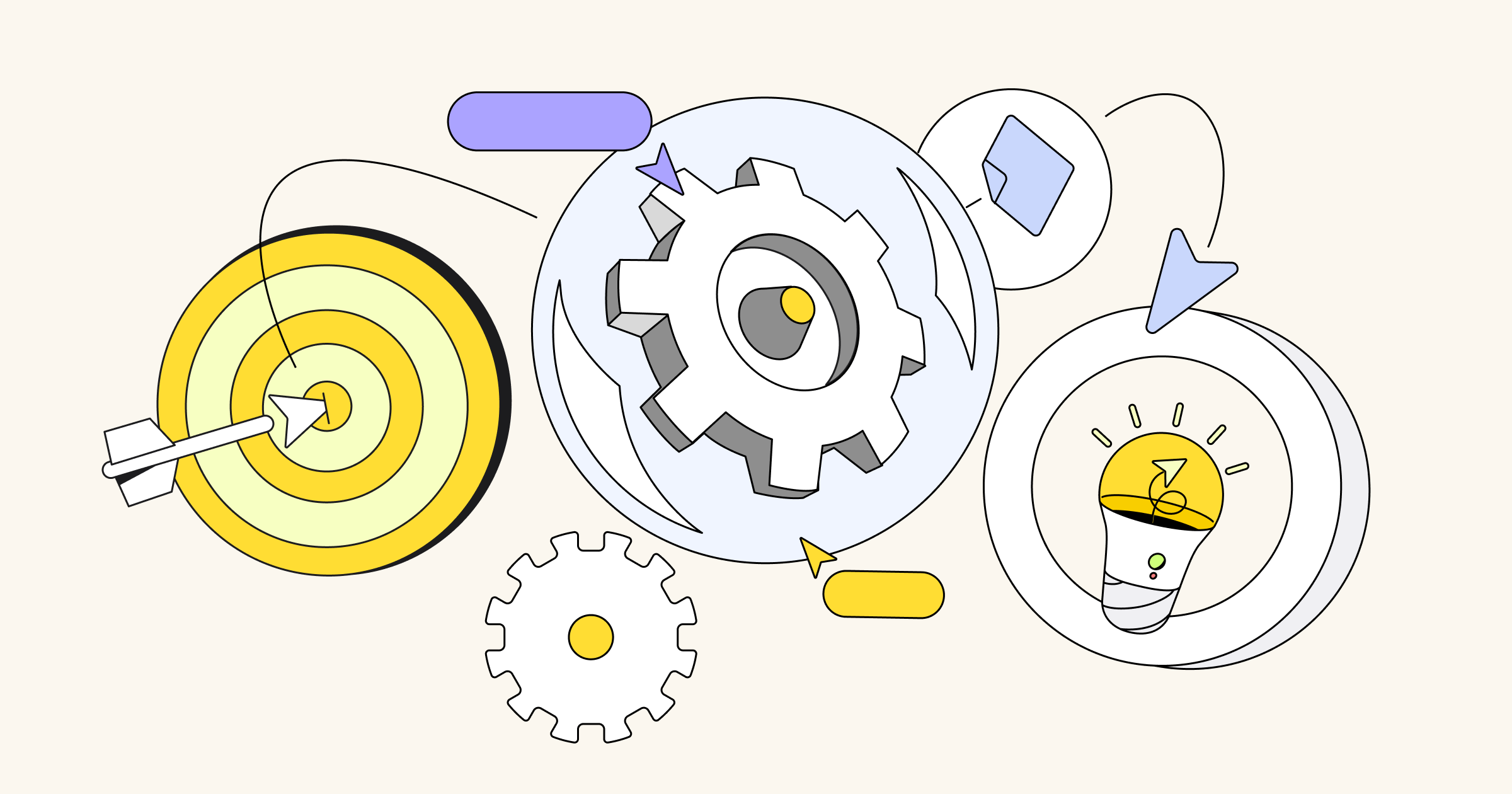Working from home is the new norm, with most employees embracing remote work.
Flexible work models have plenty of benefits for both employees and companies while having little to no negative impact on productivity levels.
However, distributed teams have their own challenges. Managers must adapt to workers in different time zones, implement asynchronous communication, and ensure remote workers are still engaged.
In this article, we’ll provide 10 tips to help leaders effectively manage distributed teams and list the essential tools their teams need.
What is a distributed team?
A distributed team is one where the employees work remotely from various physical locations. Your employees could be spread out over the country or even globally.
This work model offers extra flexibility for employees and allows them to be productive while working in comfortable environments.
In a 2021 survey, 84% of employees said working from home made them happy, and 82% said it was better for their mental health.

From a managerial perspective, distributed teams are great, but they do pose greater communication and monitoring challenges. For example, team bonding is harder to foster within a fully online team, where coworkers are just a name on the screen.
Managers rely on online collaboration, communication, and project management tools to overcome these issues.
The differences between distributed teams and remote teams
Before diving into managing distributed teams, it’s crucial to understand how a distributed team differs from a typical remote team. Here are some key variations between the two.

- Distributed teams don’t have headquarters or common office space. Based on employee location, remote teams can have headquarters or an on-site office in multiple physical locations.
- Distributed teams consist entirely of work-from-home workers. Remote teams can be completely work-from-home or have on-site offices for occasional meetings.
- Distributed teams are cheaper for companies than remote teams. This is mainly because companies don’t have to pay for equipment, office leases, and maintenance.
- Distributed teams can lead to more employee isolation than remote teams since workers in the latter model can head to the office and bond with coworkers if needed.
The pandemic has blurred the lines between the two work models, but the best practices we share below can help managers create productive employees in both.
10 best practices for managing distributed teams
Managing a distributed team involves ensuring multiple moving components are working correctly from a completely different location. While this sounds daunting, managers have online tools for smoother remote collaboration and can use these best practices to get the most from their team.

#1. Perfect the onboarding process
Remote onboarding is the process of integrating new remote employees into the organization and giving them the tools and guidelines required to be effective.
Your onboarding shouldn’t just inform them of work duties. It should help the new employee understand the company culture and really get to know their team and managers.
Team leads can use checklists or project boards to keep track of everything the new employee needs to learn and assimilate.

In the onboarding phase, you can conduct ice-breaker events to help the team bond. Regular video calls, an onboarding buddy, and multiple feedback sessions are vital to making the employee feel valued and part of the team.
#2. Prioritize communication
Provide extensive detail about every task, activity, rule, or responsibility. The goal here is to avoid ambiguity and misunderstandings while helping team members achieve team or company goals.
Repeat team-specific goals in meetings and use them as a performance metric during review and feedback sessions. When everyone is aligned on the goals, they know what they’re working toward.
Also include all team members in a collaborative project management tool, where tasks and work processes are listed. This adds transparency to the workflow and shows distributed employees how their work impacts the project.
#3. Clearly define roles and responsibilities
Spend time clarifying the roles and responsibilities of each team member. Employees can often get confused about their exact duties in a distributed team, especially when working on multiple projects.
Avoid confusion and prevent strenuous workloads by defining concrete responsibilities. For example, you can use an organizational chart to help identify each role.

You can use tools like the RACI Matrix to provide clarity for specific project-related tasks and communication.
Shared documents and workspaces are the key to successful remote collaboration.
#4. Hold regular meetings
Large email chains and message threads can hinder productivity. Constant back-and-forths deflect employee concentration from their tasks. To minimize this distraction, you can hold regular meetings to discuss critical points once or twice a week. An hour-long meeting is better than an entire day of messages and clarifications.
Team meetings can also be used to summarize previous discussions and finalize plans of action.
To keep remote employees engaged and avoid isolation, hold one-on-one meetings to address doubts and discuss progress. Solo sessions can also help address doubts or issues that a team member doesn’t want to discuss in group chats or meetings.
These meetings can also be used for employee appreciation and to show them that you care about their achievements.
#5. Offer feedback
Feedback is crucial for distributed teams. A one-way communication hierarchy where managers dictate what employees do without concern for their work needs can lead to high employee turnover.
After project completion, leaders must hold team feedback sessions to review what went well and where there could be improvements.
Feedback sessions are also a tool to track progress. If there is no improvement in team productivity or employee satisfaction after multiple review sessions, it might be time for significant organizational changes.

You can use retrospective meeting templates to facilitate this.
Apart from team sessions, schedule one-on-one feedback sessions with each employee. These don’t have to be held every week, but they must be held more than once or twice a year.
During these meetings, encourage two-way communication; you give AND receive feedback.
Feedback meetings help managers understand how employees truly feel. They can also get pointers on how to improve work processes.
#6. Trust your employees
Hovering over every employee’s workspace might seem impossible to do remotely, but it happens. When managers look into every document their employee is working on or badger them with repeated questions, employees become overwhelmed and disengaged.
Distributed team managers must trust their employees to complete their work and only step in when things aren’t on track.
This added autonomy also provides remote employees the flexibility to set their own schedules, as long as deadlines are met.
#7. Use the right tools
A successful remote team relies heavily on the tools they use. Here are a few that can help your team excel:
- Collaboration: Miro, Slack, Microsoft Teams, Discord, Google Suite.
- Project management: Asana, monday.com, Basecamp, ClickUp.
- Video meetings: Google Meet, Zoom, Skype.
- Video messaging: Loom, Vidyard.
- Storage: Google Drive, Dropbox.
Teams typically try out multiple tools before landing on the ones that work best for their processes. It’s not really about the tools but how your team uses them.
Miro, for example, can be used for multiple purposes, including collaborative brainstorming, designing, planning, and video meetings. Plus, it’s easy to keep things centralized with our suite of integrations, including the entire Google workspace.

Leaders must use tools that integrate with each other to create a seamless work process, where every task can be managed from start to finish across multiple platforms.
We’ll talk more about tools and how to use them in the next section.
#8. Promote team bonding
Hold informal team bonding events where employees can bond outside of their work. Talking to their colleagues and having casual conversations promotes camaraderie and prevents isolation.
Examples of good remote team-building activities include hosting video meetings to play a game, a book club, or even a casual hang out with coffee. Workshops are another way to encourage team bonding.
These activities are strictly non-work, meaning no “shop talk.” They are intended to be the online version of a company dinner after work on Friday.
You can schedule these meetings as often as you’d like. Experiment with timings and activities until you strike the right balance.
#9. Celebrate good results
Employees don’t want to feel like another cog in the machine. Or, in the case of distributed teams, another name in the email list.
They want to feel like they’re a part of a team striving toward common goals. One way to foster this feeling is to always celebrate the wins.
When employees achieve something or exceed expectations, you can give them a shout out at the beginning of a meeting or in an internal newsletter.

Being appreciated for their work and gaining recognition from their peers motivates high achievers to continue their streak while giving other team members something to aim for.
You can also offer small gift cards or merch to a top-performing employee every month.
#10. Create boundaries
Work-life balance plays a major role in employee retention. In a 2021 survey, 88% of employees said they changed jobs to improve work-life balance.
It’s tempting for managers to think that since all communication is online, they can expect employees to reply 24/7. But from an employee’s perspective, this is frustrating and interrupts their downtime.
Managers need to respect time zones and define set communication hours when employees are expected to respond. Anything sent after these hours is to be considered during the next working day.
Apart from timings, boundaries also need to be set for communication throughout the workforce. These rules state how communication occurs and what is appropriate when talking to colleagues, managers, and clients.
Tools to manage distributed teams
To efficiently manage a distributed team, you need to have the proper tools. The main focus of these tools should be to facilitate collaborative online work.
You don’t want to use tools that are complicated to set up and use. Instead, you want an intuitive user interface that every team member can easily use regardless of their technical capabilities.
Here are the different types of tools you need to manage a distributed team:
- Collaboration
- Since every distributed team relies on collaboration, you’ll need tools to enable effortless communication and collective work capabilities.
- Choose tools that are updated in real-time, enable communication within context via comment threads within the workspace, and are useful to multiple teams within your organization. Miro is an excellent example of this.

Other popular collaboration tools include Nextiva, Slack, and Microsoft Teams. Each of these serves its purpose.
- Project Management
Project management is the process of creating and monitoring tasks to ensure they’re completed on time. Project managers (PMs) rely on online software to do this.
With a project management tool like monday.com or Basecamp, managers can get an overview of all the tasks within a project in one place. They can use this overview to identify potential delays and bottlenecks and take steps to solve them.
- Video Conferencing
Distributed teams need to have regular video meetings, and the most popular choice for these is Zoom or Google Meet. Skype is also in the mix.
All three platforms are known for their ability to handle large team meetings, enable presentations, and have features that help smoothly conduct a meeting, like “push to talk,” for example.
- Instant Messaging and Email
Instant messaging platforms like Slack or Discord and email providers like Gmail are essential for distributed teams. These platforms help with group and individual communications.
While they are excellent for communication, it’s essential to set time limits and respect boundaries when using these apps.
- Cloud HR tools
Make HR management a breeze with a cloud HR tool like BambooHR or Gusto. These tools simplify HR processes, including recruitment, onboarding, and payroll.
PMs can also use these tools for time-tracking tasks and measuring productivity.
Conclusion
Managing a distributed team is easier when you have the right work processes in place and use the proper tools. Take advantage of an online collaborative whiteboard like Miro to plan your work strategy and foster a collaborative work environment where every employee thrives.
Whether it’s for remote employee onboarding, appreciation, or collaboration, Miro has the features to help you out. You can also learn more about remote work best practices in our detailed guide.




